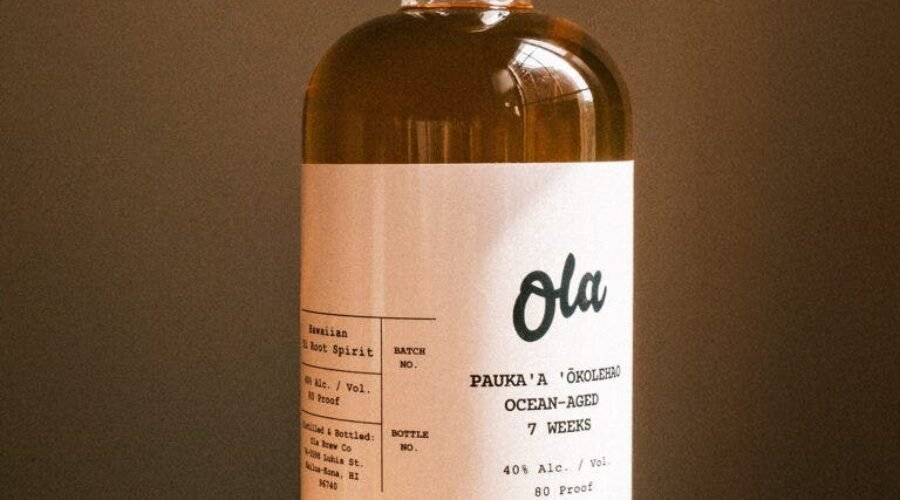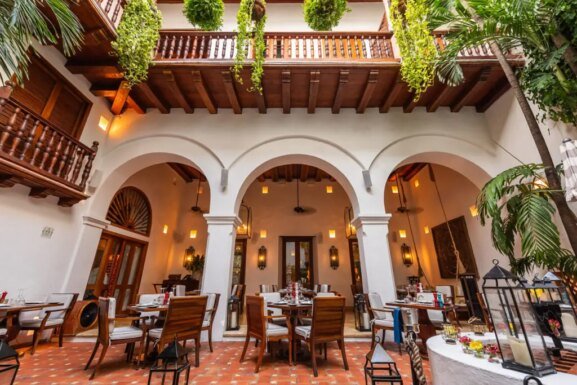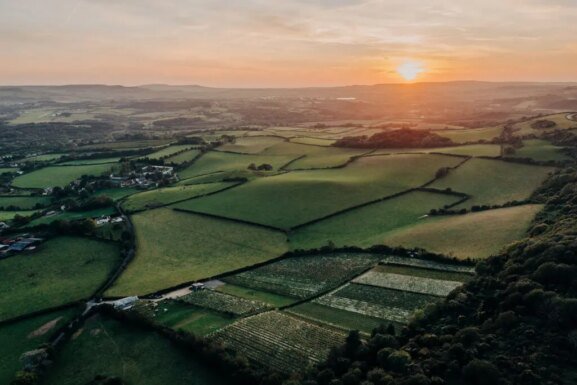In Hawai‘i, a Once Banned Spirit Is Getting a Second Chance
Naehalani Breeland’s footsteps crunched on gravel as she turned to survey the old Hilo Sugar Mill, which had overlooked the blue waters of Hilo Bay for centuries. The building’s exterior still labels it as property of C. Brewer & Co., once a business powerhouse in Hawai‘i, established in 1826.
Almost 200 years later, the 10-acre site now belongs to Ola Brew. The facility that used to store sugar will soon open as a distillery for ‘ōkolehao, a spirit made in Hawai‘i from the roots of kī (ti plant).
“There are people on the island who were born and raised here, and they’ve never been here because this was such a closed-off location,” said president and co-founder Breeland. “We’re now able to open this up to our community.”
‘Ōkolehao—which translates to “iron bottom”—is a liquor of legend in Hawai‘i that’s been difficult to procure in recent decades. Long considered a moonshine, it fell out of favor during Prohibition, though the collective memory of kūpuna (elders) kept it alive. Today, it’s returned to the limelight, thanks to local distillers.
Among Native Hawaiians, the reception of its revitalization runs the gamut. However, one point is agreed upon: In the olden days, both ali‘i (royalty) and maka‘āinana (commoners) imbibed it with relish. Some Kānaka Maoli (Native Hawaiians), such as Kāwika Lewis, a resident of Hawai‘i Island, see ‘ōkolehao’s resurgence as a pathway toward reviving recipes and educating people about Hawaiian history.
“I think it’s a good thing,” Lewis said. “It can also bring knowledge of Hawai‘i and its traditional ways.”
// Create the element
var script_68cd9e107fd5f = document.createElement(“script”);
script_68cd9e107fd5f.innerHTML = `
window.googletag = window.googletag || {cmd: []};
googletag.cmd.push(function() {
var adType = “leaderboard”;
var mapping;
var lbmapping = googletag.sizeMapping()
.addSize([1024, 0], [[970, 250], [970, 90], [1, 1], [728, 90]])
.addSize([728, 0], [[728, 90], [1, 1]])
.addSize([320, 0], [[1, 1], [300, 50], [300, 100], [320, 50], [320, 100]])
.addSize([0, 0], [[1, 1], [320, 50]])
.build();; // Size mapping for leaderboard ads
var medrecmapping = googletag.sizeMapping()
.addSize([1024, 0], [[300, 600],[300, 250]])
.addSize([728, 0], [300, 250])
.addSize([320, 0], [[1, 1],[300, 250]])
.addSize([0, 0], [[1, 1], [300, 250]])
.build(); // Size mapping for med rectengle ads
if(‘/39808611/article_page/article_leaderboard_1’ == ‘/39808611/article_page/article_leaderboard_1’
|| ‘/39808611/article_page/article_leaderboard_1’ == ‘/39808611/article_page/article_leaderboard_2’
|| ‘/39808611/article_page/article_leaderboard_1’ == ‘/39808611/article_page/article_leaderboard_3’) {
mapping = googletag.sizeMapping()
.addSize([1920, 0], [[728, 90]]) // >= 1920px
.addSize([1440, 0], [[728, 90]]) // 1440px-1919px
.addSize([730, 0], [[300, 250]]) // 730px-1439px
.addSize([0, 0], [[320, 100], [320, 50], [300, 100], [300, 50], [300, 250]]) // Up to 729px
.build();
} else {
mapping = adType == ‘leaderboard’ ? lbmapping : medrecmapping;
}
googletag.defineSlot(‘/39808611/article_page/article_leaderboard_1’, [],
‘div-gpt-ad-68cd9e107fd5f’).addService(googletag.pubads()).defineSizeMapping(mapping);
googletag.pubads().enableSingleRequest();
googletag.pubads().collapseEmptyDivs();
googletag.display(‘div-gpt-ad-68cd9e107fd5f’);
});
`;
// Append the script to the body
document.body.appendChild(script_68cd9e107fd5f);
Others, including Ha‘aheo Auwae-Dekker, resident of O‘ahu, hold complicated feelings about the drink because of kī’s sacred role in Hawaiian culture and alcohol’s problematic nature on the islands.
“Why would we use this traditionally ceremonial plant to create alcohol?” Auwae-Dekker asked. “Something that has notoriously been horrible to Kānaka because of generational trauma, because of colonialism.”
Breeland, who identifies as Kānaka Maoli, acknowledges the controversy around alcohol and the question of whether there’s a cultural place for it.
“What we’re doing here is honoring ‘āina,” or land, she said. “We’re honoring a significant plant in Hawai‘i, and we’re creating something that is 100% Hawai‘i-grown, which in and of itself is a big feat.
Distilling runs in her koko (blood). Her great-grandfather Joseph Ahuna was nicknamed “the king of the bootleggers” in Waikīkī, O‘ahu. On a tour of Ola’s distillery site earlier this year, Breeland imagined its future: stills, a speakeasy, a barrel-aging tunnel, and more.
She pointed to folklore and mo‘olelo (stories) about ‘ōkolehao in Hawai‘i. She wants to be part of its resurrection.
“I am a huge proponent of our culture and a huge proponent of honoring our cultural practices,” Breeland said. “So I will never say that ‘ōkolehao is a traditional spirit, but it does have history.”
That history isn’t well-documented, said Brett Jacobson, Ola’s CEO and co-founder, but his team has traced it to the late 18th century. Sailors first introduced distillation practices to the Hawaiian Kingdom, Jacobson said.

King Kamehameha I banned ‘ōkolehao, though other leaders like King David Kalākaua reversed course due to their love of the spirit, Jacobson said. “The different kings over the years had their different opinions on it,” he added.
As time passed, and Hawai‘i was illegally annexed by the U.S. in 1898, its sugar industry boomed, with American and British planters recruiting laborers from other countries to toil alongside Native Hawaiians. Plantation workers from countries like the Philippines, China, and Japan influenced the composition of ‘ōkolehao. “It had so many hands in it—pineapple and rice and papaya, distill it this way or use this kind of yeast,” said Jacobson, who is not ‘ōiwi (Native).


It devolved from the original recipe made of 100% kī root. But according to Jacobson’s research, traditional ‘ōkolehao—from kī grown in Big Island’s Waipi’o Valley and distilled on the Kona side—was entered into the 1889 World’s Fair in Paris and won an award.
“That’s what we’ve been trying to do, replicate that,” Jacobson said.
Like its ancestor, the ‘ōkolehao produced by Ola is also earning accolades. Unaged ‘ōkolehao can be treated like a premium tequila to whip up margaritas and other cocktails, Jacobson said, though the aged variation is a sipping spirit.
His business plan includes opening the distillery in October or November, around the same time that Ola’s ‘ōkolehao will be available for purchase. For now, Ola produces the spirit at its existing distillery adjacent to its Kona brewery. Though the brand’s ‘ōkolehao will only be sold in Hawai‘i for at least the next two years, Jacobson hopes to sell bottles in select U.S. cities soon after.
Ola aims to expand beyond its current 40-acre farm, with efforts underway to obtain 250 acres of land. If the brand can build a large market for ‘ōkolehao, then Jacobson estimates that tens of thousands of acres will be dedicated to kī. He hopes it will spur demand for organic and regenerative agriculture.
“Our goal is really to lower the amount of chemical fertilizers, pesticides, and herbicides that end up in the streams and the ocean,” he said.
We’re honoring a significant plant in Hawai‘i, and we’re
creating something that is 100% Hawai‘i-grown, which in and of itself is a big feat.Naehalani Breeland
// Create the element
var script_68cd9e1080bdf = document.createElement(“script”);
script_68cd9e1080bdf.innerHTML = `
window.googletag = window.googletag || {cmd: []};
googletag.cmd.push(function() {
var adType = “leaderboard”;
var mapping;
var lbmapping = googletag.sizeMapping()
.addSize([1024, 0], [[970, 250], [970, 90], [1, 1], [728, 90]])
.addSize([728, 0], [[728, 90], [1, 1]])
.addSize([320, 0], [[1, 1], [300, 50], [300, 100], [320, 50], [320, 100]])
.addSize([0, 0], [[1, 1], [320, 50]])
.build();; // Size mapping for leaderboard ads
var medrecmapping = googletag.sizeMapping()
.addSize([1024, 0], [[300, 600],[300, 250]])
.addSize([728, 0], [300, 250])
.addSize([320, 0], [[1, 1],[300, 250]])
.addSize([0, 0], [[1, 1], [300, 250]])
.build(); // Size mapping for med rectengle ads
if(‘/39808611/article_page/article_leaderboard_2’ == ‘/39808611/article_page/article_leaderboard_1’
|| ‘/39808611/article_page/article_leaderboard_2’ == ‘/39808611/article_page/article_leaderboard_2’
|| ‘/39808611/article_page/article_leaderboard_2’ == ‘/39808611/article_page/article_leaderboard_3’) {
mapping = googletag.sizeMapping()
.addSize([1920, 0], [[728, 90]]) // >= 1920px
.addSize([1440, 0], [[728, 90]]) // 1440px-1919px
.addSize([730, 0], [[300, 250]]) // 730px-1439px
.addSize([0, 0], [[320, 100], [320, 50], [300, 100], [300, 50], [300, 250]]) // Up to 729px
.build();
} else {
mapping = adType == ‘leaderboard’ ? lbmapping : medrecmapping;
}
googletag.defineSlot(‘/39808611/article_page/article_leaderboard_2’, [],
‘div-gpt-ad-68cd9e1080bdf’).addService(googletag.pubads()).defineSizeMapping(mapping);
googletag.pubads().enableSingleRequest();
googletag.pubads().collapseEmptyDivs();
googletag.display(‘div-gpt-ad-68cd9e1080bdf’);
});
`;
// Append the script to the body
document.body.appendChild(script_68cd9e1080bdf);
Ola has turned to crowdfunding to build excitement and raised over $3 million from about 1,800 investors. “How do you get community support? You have the community own it,” Jacobson said. “You can’t buy people’s support. The best way to get it is to give them equity.”
The company’s moves have made an impression on locals.
“There’s a lot of talk about it,” says Lewis, a Kānaka Maoli who lives in Waiākea-Uka near Ola’s farm. He first heard about ‘ōkolehao as a child and was under the impression that it was a homemade spirit. On Hawai‘i, locals have commonly distilled fruity moonshines, Lewis explained.
He wants to ensure ‘ōkolehao is distilled on Hawai‘i, lest it be made elsewhere, and the islands are used as a marketing tool for sales. “If it’s made in Hawai‘i, I’m cool with that,” he said.
Ultimately, Lewis believes it comes down to the intentions of the distillers. But Auwae-Dekker doesn’t foresee ‘ōkolehao in their future.
“At least in my little circle, and in my life, I don’t think I see myself engaging in ‘ōkolehao anytime soon,” they said. “And maybe I’ll be proven wrong.”
Auwae-Dekker believes ‘ōkolehao is an example of globalization’s impact on Hawai‘i because Kānaka Maoli didn’t originally produce it. “Alcohol is not really a thing that we engaged with until being introduced to alcohol by sailors,” they said.
It also comes down to cost. “In this economy, I don’t know if I have the money to spend on specialty spirits,” Auwae-Dekker joked.

On Kaua‘i, the couple behind Hanalei Spirits Distillery in Kīlauea is also contributing to the resurrection of ‘ōkolehao.
Vindi Wells has spent her life on Kaua‘i, while her husband, Grant, was born on Aotearoa, the Māori name for New Zealand, and raised on Kaua‘i. Though neither is Native Hawaiian, they both learned about ‘ōkolehao as adolescents. Vindi recalls seeing elders at weddings and funerals offering people nips of ‘ōkolehao.
// Create the element
var script_68cd9e10811a2 = document.createElement(“script”);
script_68cd9e10811a2.innerHTML = `
window.googletag = window.googletag || {cmd: []};
googletag.cmd.push(function() {
var adType = “leaderboard”;
var mapping;
var lbmapping = googletag.sizeMapping()
.addSize([1024, 0], [[970, 250], [970, 90], [1, 1], [728, 90]])
.addSize([728, 0], [[728, 90], [1, 1]])
.addSize([320, 0], [[1, 1], [300, 50], [300, 100], [320, 50], [320, 100]])
.addSize([0, 0], [[1, 1], [320, 50]])
.build();; // Size mapping for leaderboard ads
var medrecmapping = googletag.sizeMapping()
.addSize([1024, 0], [[300, 600],[300, 250]])
.addSize([728, 0], [300, 250])
.addSize([320, 0], [[1, 1],[300, 250]])
.addSize([0, 0], [[1, 1], [300, 250]])
.build(); // Size mapping for med rectengle ads
if(‘/39808611/article_page/article_leaderboard_2’ == ‘/39808611/article_page/article_leaderboard_1’
|| ‘/39808611/article_page/article_leaderboard_2’ == ‘/39808611/article_page/article_leaderboard_2’
|| ‘/39808611/article_page/article_leaderboard_2’ == ‘/39808611/article_page/article_leaderboard_3’) {
mapping = googletag.sizeMapping()
.addSize([1920, 0], [[728, 90]]) // >= 1920px
.addSize([1440, 0], [[728, 90]]) // 1440px-1919px
.addSize([730, 0], [[300, 250]]) // 730px-1439px
.addSize([0, 0], [[320, 100], [320, 50], [300, 100], [300, 50], [300, 250]]) // Up to 729px
.build();
} else {
mapping = adType == ‘leaderboard’ ? lbmapping : medrecmapping;
}
googletag.defineSlot(‘/39808611/article_page/article_leaderboard_2’, [],
‘div-gpt-ad-68cd9e10811a2’).addService(googletag.pubads()).defineSizeMapping(mapping);
googletag.pubads().enableSingleRequest();
googletag.pubads().collapseEmptyDivs();
googletag.display(‘div-gpt-ad-68cd9e10811a2’);
});
`;
// Append the script to the body
document.body.appendChild(script_68cd9e10811a2);
Now, she and Grant manage an eight-acre farm where hundreds of thousands of kī bound to become ‘ōkolehao grow alongside hardwood trees, liliko‘i (passion fruit), ‘ulu (breadfruit), and more. “We really want to continue that long history of agriculture that we have here in Hawai‘i,” Vindi said.
Hanalei Spirits Distillery was incorporated in 2016, with an initial focus on sugarcane vodka, taro vodka, and white rum. Around 2021, the Wellses sold their first bottle of ‘ōkolehao.
Though the business has had to teach more recent residents about ‘ōkolehao, Grant considers longtime locals as largely supportive of their efforts.
“The demand for it is off the hook,” Vindi added. “We feel like we’re keeping something alive.”
Author’s note: Megan Ulu-Lani Boyanton identifies as Kānaka Maoli.
This article originally appeared in the November 2025 Best Buys Issue of Wine Enthusiast magazine. Click here to subscribe today!
More Stories from the November Issue
- Wine Enthusiast’s Top 100 Best Buys list signals 2025 as a year with outstanding value.
- Discover thriving Pinot Noir at the world’s Southernmost wine region.
- New Jersey wine from its Warren Hills AVA is quietly turning heads.
- Digital Editorial Director Rachel Tepper Paley’s states her case for the half-pour.
- A Ukrainian veteran’s mission to revive kontabas, the country’s traditional black currant spirit.

In the Shop
Dial-a-Recipe Cocktail Shaker and Bar Tools Set
In Stock | $24.99
The post In Hawai‘i, a Once Banned Spirit Is Getting a Second Chance appeared first on Wine Enthusiast.


